Mosses as Biomonitors of Atmospheric Trace Metal and Nitrogen Deposition: Spatial Distribution and Temporal Trend in Yancheng, China
Abstract
:1. Introduction
2. Results
2.1. Metal Concentrations and Contamination Scale in 2022
2.2. Spatial Patterns of Trace Metals in 2022 and Temporal Trends Since 2017
2.3. Spatial Patterns of Nitrogen in 2022 and Temporal Trends Since 2017
2.4. Source Appointment of Trace Metals and Nitrogen in 2022
3. Discussion
3.1. Metal Concentrations and Contamination Scale in 2022
3.2. Trace Metals—Spatial Patterns in 2022 and Temporal Trends Since 2017
3.3. Nitrogen—Spatial Patterns in 2022 and Temporal Trends Since 2017
3.4. Source Appointment of Trace Metals and Nitrogen in 2022
4. Materials and Methods
4.1. Description of the Study Area
4.2. Sampling Procedure
4.3. Elemental Analysis and Quality Assurance
4.4. Mapping
4.5. Statistical Analysis
5. Conclusions
Supplementary Materials
Author Contributions
Funding
Data Availability Statement
Conflicts of Interest
References
- Lazo, P.; Stafilov, T.; Qarri, F.; Allajbeu, S.; Bekteshi, L.; Frontasyeva, M.; Harmens, H. Spatial distribution and temporal trend of airborne trace metal deposition in Albania studied by moss biomonitoring. Ecol. Indic. 2019, 101, 1007–1017. [Google Scholar] [CrossRef]
- Li, Y.; Zhou, S.L.; Jia, Z.Y.; Liu, K.; Wang, G.M. Temporal and spatial distributions and sources of heavy metals in atmospheric deposition in western Taihu Lake, China. Environ. Pollut. 2021, 284, 117465. [Google Scholar] [CrossRef]
- Olmstead, E.; Aherne, J. Are tissue concentrations of Hylocomium splendens a good predictor of nitrogen deposition? Atmos. Pollut. Res. 2019, 10, 80–87. [Google Scholar] [CrossRef]
- Amodio, M.; Catino, S.; Dambruoso, P.R.; de Gennaro, G.; Di Gilio, A.; Giungato, P.; Laiola, E.; Marzocca, A.; Mazzone, A.; Sardaro, A.; et al. Atmospheric deposition: Sampling procedures, analytical methods, and main recent findings from the scientific literature. Adv. Meteorol. 2014, 2014, 161730. [Google Scholar] [CrossRef]
- Chen, Y.R.; Wang, Q.F.; Zhu, J.X.; Xi, Y.; Zhang, Q.Y.; Dai, G.H.; He, N.P.; Yu, G.R. Atmospheric wet iron, molybdenum, and vanadium deposition in Chinese terrestrial ecosystems. Environ. Sci. Technol. 2022, 56, 12898–12905. [Google Scholar] [CrossRef]
- Li, Y.; Yu, Y.; Li, Y.; Jiang, J.; Wang, L.J.; Wang, G.M.; Zhang, H.C.; Li, N.; Xie, X.F.; Cheng, X.Y.; et al. A combined method for human health risk area identification of heavy metals in urban environments. J. Hazard. Mater. 2023, 449, 131067. [Google Scholar] [CrossRef]
- Tripathee, L.; Kang, S.C.; Chen, P.F.; Bhattarai, H.; Guo, J.M.; Shrestha, K.L.; Sharma, C.M.; Ghimire, P.S.; Huang, J. Water-soluble organic and inorganic nitrogen in ambient aerosols over the Himalayan middle hills: Seasonality, sources, and transport pathways. Atmos. Res. 2021, 250, 105376. [Google Scholar] [CrossRef]
- Harmens, H.; Norris, D.A.; Sharps, K.; Mills, G.; Alber, R.; Aleksiayenak, Y.; Blum, O.; Cucu-Man, S.M.; Dam, M.; De Temmerman, L.; et al. Heavy metal and nitrogen concentrations in mosses are declining across Europe whilst some “hotspots” remain in 2010. Environ. Pollut. 2015, 200, 93–104. [Google Scholar] [CrossRef]
- Frontasyeva, M.; Harmens, H.; Uzhinskiy, A.; Chaligava, O.; Participants of the Moss Survey. Mosses as biomonitors of air pollution: 2015/2016 survey on heavy metals, nitrogen and POPs in Europe and beyond. In Report of the ICP Vegetation Moss Survey; Coordination Centre, Joint Institute for Nuclear Research, Dubna, Russian Federation: Dubna, Russia, 2020; p. 136. ISBN 978-5-9530-0508-1. [Google Scholar]
- Harmens, H.; Foan, L.; Simon, V.; Mills, G. Terrestrial mosses as biomonitors of atmospheric POPs pollution: A review. Environ. Pollut. 2013, 173, 245–254. [Google Scholar] [CrossRef]
- Schröder, W.; Nickel, S. Moss species-specific accumulation of atmospheric deposition? Environ. Sci. Eur. 2019, 31, 78. [Google Scholar] [CrossRef]
- Schröder, W.; Nickel, S.; Schönrock, S.; Meyer, M.; Wosniok, W.; Harmens, H.; Frontasyeva, M.V.; Alber, R.; Aleksiayenak, J.; Barandovski, L.; et al. Spatially valid data of atmospheric deposition of heavy metals and nitrogen derived by moss surveys for pollution risk assessments of ecosystems. Environ. Sci. Pollut. Res. 2016, 23, 10457–10476. [Google Scholar] [CrossRef] [PubMed]
- Ye, J.X.; Li, J.J.; Wang, P.C.; Ning, Y.Q.; Liu, J.L.; Yu, Q.Q.; Bi, X.Y. Inputs and sources of Pb and other metals in urban area in the post leaded gasoline era. Environ. Pollut. 2022, 306, 119389. [Google Scholar] [CrossRef] [PubMed]
- Hu, Y.A.; Yang, S.; Cheng, H.F.; Tao, S. Systematic evaluation of two classical receptor models in source apportionment of soil heavy metal(loid) pollution using synthetic and real-world datasets. Environ. Sci. Technol. 2022, 56, 17604–17614. [Google Scholar] [CrossRef]
- Xu, B.; Xu, H.; Zhao, H.; Gao, J.; Liang, D.N.; Li, Y.; Wang, W.; Feng, Y.C.; Shi, G.L. Source apportionment of fine particulate matter at a megacity in China, using an improved regularization supervised PMF model. Sci. Total. Environ. 2023, 879, 163198. [Google Scholar] [CrossRef] [PubMed]
- Zhou, X.L.; Sylvester, S.P.; Hu, R.; Wang, Y.N.; Fang, Y.M. Patterns and sources of atmospheric nitrogen deposition in Yancheng, Eastern China, indicated by moss N concentration and δ15N signatures. Atmos. Pollut. Res. 2019, 10, 1601–1609. [Google Scholar] [CrossRef]
- Zhou, X.L.; Hu, R.; Fang, Y.M. Source and spatial distribution of airborne heavy metal deposition studied using mosses as biomonitors in Yancheng, China. Environ. Sci. Pollut. Res. 2021, 28, 30758–30773. [Google Scholar] [CrossRef]
- Shakya, K.; Chettri, M.K.; Sawidis, T. Use of mosses for the survey of heavy metal deposition in ambient air of the Kathmandu valley applying active monitoring technique. Ecoprint Int. J. Ecol. 2014, 19, 17–29. [Google Scholar] [CrossRef]
- Pitcairn, C.E.R.; Leith, I.D.; Sheppard, L.J.; Sutton, M.A.; Fowler, D.; Munro, R.C.; Tang, S.; Wilson, D. The relationship between nitrogen deposition, species composition and foliar nitrogen concentrations in woodland flora in the vicinity of livestock farms. Environ. Pollut. 1998, 102, 41–48. [Google Scholar] [CrossRef]
- Xiao, J.; Han, X.X.; Sun, S.Q.; Wang, L.Q.; Rinklebe, J. Heavy metals in different moss species in alpine ecosystems of Mountain Gongga, China: Geochemical characteristics and controlling factors. Environ. Pollut. 2021, 272, 115991. [Google Scholar] [CrossRef]
- Xu, Y.Y.; Zhao, Y.Z.; Yi, Y. Fluxes and sources of metals deposited in dew in Changchun, China. Atmos. Pollut. Res. 2023, 14, 101729. [Google Scholar] [CrossRef]
- Lin, D.; Meng, J.W.; Li, M.N.; Wu, Q.F.; Wang, L.P.; Li, X.J.; Song, J.J.; Zhao, L.C.; Xu, P.; Xia, Y.; et al. Active biomonitoring of atmospheric element deposition using evernia mesomorpha in Tangshan, China. Appl. Ecol. Environ. Res. 2024, 22, 1191–1205. [Google Scholar] [CrossRef]
- Varela, Z.; Fernandez, J.A.; Real, C.; Carballeira, A.; Aboal, J.R. Influence of the physicochemical characteristics of pollutants on their uptake in moss. Atmos. Environ. 2015, 102, 130–135. [Google Scholar] [CrossRef]
- García-Seoane, R.; Antelo, J.; Fiol, S.; Fernández, J.A.; Aboal, J.R. Unravelling the metal uptake process in mosses: Comparison of aquatic and terrestrial species as air pollution biomonitors. Environ. Pollut. 2023, 333, 122069. [Google Scholar] [CrossRef] [PubMed]
- Gallego-Cartagena, E.; Morillas, H.; Carrero, J.A.; Madariaga, J.M.; Maguregui, M. Naturally growing grimmiaceae family mosses as passive biomonitors of heavy metals pollution in urban-industrial atmospheres from the Bilbao Metropolitan area. Chemosphere 2021, 263, 128190. [Google Scholar] [CrossRef] [PubMed]
- He, C.; Kumar, R.; Tang, W.F.; Pfister, G.; Xu, Y.Y.; Qian, Y.; Brasseur, G. Air Pollution interactions with weather and climate extremes: Current knowledge, gaps, and future directions. Curr. Pollut. Rep. 2024, 10, 430–442. [Google Scholar] [CrossRef]
- Wang, J.; Ge, B.; Kong, L.; Chen, X.; Li, J.; Lu, K.; Dong, Y.; Su, H.; Wang, Z.; Zhang, Y. Quantitative decoupling analysis for assessing the meteorological, emission, and chemical influences on fine particle pollution. J. Adv. Model. Earth Syst. 2024, 16, e2024MS004261. [Google Scholar] [CrossRef]
- Jiang, S.L.; Dong, X.Y.; Han, Z.M.; Zhao, J.R.; Zhang, Y. Emissions and atmospheric dry and wet deposition of trace metals from natural and anthropogenic sources in mainland China. Atmosphere 2024, 15, 402. [Google Scholar] [CrossRef]
- Yancheng Water Resources Bureau. Available online: https://slj.yancheng.gov.cn/ (accessed on 6 February 2025).
- Abou-Ghanem, M.; Murphy, D.M.; Schill, G.P.; Lawler, M.J.; Froyd, K.D. Measurement report: Vanadium-containing ship exhaust particles detected in and above the marine boundary layer in the remote atmosphere. Atmos. Chem. Phys. 2024, 24, 8263–8275. [Google Scholar] [CrossRef]
- Zhang, R.; Ma, K. New Prospects to Systematically Improve the Particulate Matter Removal Efficiency of Urban Green Spaces at Multi-Scales. Forests 2023, 14, 175. [Google Scholar] [CrossRef]
- Pan, Y.P.; Liu, J.; Zhang, L.; Cao, J.; Hu, J.B.; Tian, S.L.; Li, X.Y.; Xu, W. Bulk deposition and source apportionment of atmospheric heavy metals and metalloids in agricultural areas of rural Beijing during 2016–2020. Atmosphere 2021, 12, 283. [Google Scholar] [CrossRef]
- Wang, H.M.; Wu, J.F.; Tian, Z.Q. Study on atmospheric heavy metal deposition by environmental tracers surrounding copper smelting. Air Qual. Atmos. Health 2023, 16, 1479–1487. [Google Scholar] [CrossRef]
- Mahapatra, B.; Dhal, N.K.; Dash, A.K.; Panda, B.P.; Panigrahi, K.C.S.; Pradhan, A. Perspective of mitigating atmospheric heavy metal pollution: Using mosses as biomonitoring and indicator organism. Environ. Sci. Pollut. Res. 2019, 26, 29620–29638. [Google Scholar]
- Izquieta-Rojano, S.; Elustondo, D.; Ederra, A.; Lasheras, E.; Santamaría, C. Pleurochaete squarrosa (Brid.) Lindb. as an alternative moss species for biomonitoring surveys of heavy metal, nitrogen deposition and δ15N signatures in a Mediterranean area. Ecol. Indic. 2016, 60, 1221–1228. [Google Scholar] [CrossRef]
- Nickel, S.; Schröder, W.; Wosniok, W.; Harmens, H.; Frontasyeva, M.V.; Alber, R.; Aleksiayenak, J.; Barandovski, L.; Blum, O.; Danielsson, H.; et al. Modelling and mapping heavy metal and nitrogen concentrations in moss in 2010 throughout Europe by applying Random Forests models. Atmos. Environ. 2017, 156, 146–159. [Google Scholar] [CrossRef]
- Liu, X.; Tai, A.P.K.; Fung, K.M. Responses of surface ozone to future agricultural ammonia emissions and subsequent nitrogen deposition through terrestrial ecosystem changes. Atmos. Chem. Phys. 2021, 21, 17743–17758. [Google Scholar] [CrossRef]
- Ren, K.; Zhou, Y.L.; Liu, J.R.; Yu, Z.Y.; Ma, X.; Si, R.T.; Wen, Z.; Xu, Y.; Tang, A.; Shen, J.L.; et al. A decadal change in atmospheric nitrogen deposition at a rural site in southern China. Atmosphere 2024, 15, 583. [Google Scholar] [CrossRef]
- Yancheng Municipal People’s Government. Available online: https://www.yancheng.gov.cn (accessed on 6 February 2025).
- Gauss, M.; Bartnicki, J.; Jalkanen, J.; Nyiri, A.; Klein, H.; Fagerli, H.; Klimont, Z. Airborne nitrogen deposition to the Baltic Sea: Past trends, source allocation and future projections. Atmos. Environ. 2021, 253, 118377. [Google Scholar] [CrossRef]
- Kosonen, Z.; Thimonier, A.; Schnyder, E.; Thöni, L. Nitrogen concentration in moss compared with N load in precipitation and with total N deposition in Switzerland. Environ. Pollut. 2018, 239, 169–178. [Google Scholar] [CrossRef] [PubMed]
- Lu, C.Q.; Zhang, J.; Tian, H.Q.; Crumpton, W.G.; Helmers, M.J.; Cai, W.J.; Hopkinson, C.S.; Lohrenz, S.E. Increased extreme precipitation challenges nitrogen load management to the Gulf of Mexico. Commun. Earth. Environ. 2020, 1, 21. [Google Scholar] [CrossRef]
- Liang, J.; Feng, C.; Zeng, G.; Gao, X.; Zhong, M.Z.; Li, X.D.; Li, X.; He, X.Y.; Fang, Y.L. Spatial distribution and source identification of heavy metals in surface soils in a typical coal mine city, Lianyuan, China. Environ. Pollut. 2017, 225, 681–690. [Google Scholar] [CrossRef]
- Xu, S.; Zhang, Z.H.; Wang, Z.H. Effects of heavy metals on moss diversity and analysis of moss indicator species in Nancha manganese mining area, Southwestern China. Glob. Ecol. Conserv. 2021, 28, e01665. [Google Scholar]
- Usman, U.A.; Yusoff, I.; Raoov, M.; Alias, Y.; Hodgkinson, J.; Abdullah, N.; Hussin, N.H. Natural sources of iron and manganese in groundwater of the lower Kelantan River Basin, North-eastern coast of Peninsula Malaysia: Water quality assessment and an adsorption-based method for remediation. Environ. Earth. Sci. 2021, 80, 425. [Google Scholar] [CrossRef]
- Nguyen, L.S.P.; Do, T.T.L.; Vo, T.G.H.; Le, Q.H.; Hien, T.T. The Source and distribution of heavy metals in the atmosphere across southeast Asia. In Heavy Metal Remediation. Earth and Environmental Sciences Library; Kumar, N., Ed.; Springer: Cham, Switzerland, 2024. [Google Scholar]
- Wang, R.; Balkanski, Y.; Boucher, O.; Bopp, L.; Chappell, A.; Ciais, P.; Hauglustaine, D.; Peñuelas, J.; Tao, S. Sources, transport and deposition of iron in the global atmosphere. Atmos. Chem. Phys. 2015, 15, 6247–6270. [Google Scholar] [CrossRef]
- WorldAtlas. The Most Abundant Elements in the Earth’s Crust 2023. Available online: https://www.worldatlas.com/environment/the-most-abundant-elements-in-the-earth-s-crust.html (accessed on 6 February 2025).
- Cong, L.; Zhai, J.; Yan, G.; Liu, J.; Wu, Y.; Wang, Y.; Zhang, Z.; Zhang, M. Lead isotope trends and sources in the atmosphere at the artificial wetland. PeerJ 2019, 7, e7851. [Google Scholar] [CrossRef]
- Tao, Z.; Guo, Q.; Wei, R.; Dong, X.; Han, X.; Guo, Z. Atmospheric lead pollution in a typical megacity: Evidence from lead isotopes. Sci. Total. Environ. 2021, 778, 145810. [Google Scholar] [CrossRef]
- Adamiec, E.; Jarosz-Krzemińska, E.; Wieszała, R. Heavy metals from non-exhaust vehicle emissions in urban and motorway road dusts. Environ. Monit. Assess. 2016, 188, 369. [Google Scholar] [CrossRef]
- Jeong, H. Toxic metal concentrations and Cu–Zn–Pb isotopic compositions in tires. J. Anal. Sci. Technol. 2023, 13, 2. [Google Scholar] [CrossRef]
- Luo, Y.; Wang, Z.; Zhang, Z.L.; Huang, F.Y.; Jia, W.J.; Zhang, J.Q.; Feng, X.Y. Characteristics and source analysis of potentially toxic elements pollution in atmospheric fallout around non-ferrous metal smelting slag sites–taking southwest China as an example. Environ. Sci. Pollut. Res. 2023, 30, 7813–7824. [Google Scholar] [CrossRef]
- Huang, D.; Xu, Z.; He, Y.; Liu, M.; Jia, X.; Zhou, T. Corrosion and wear resistance of HVOF-sprayed Ni-Cr-Co multi-principal element alloy coating on copper plate. J. Therm. Spray Technol. 2024, 33, 1585–1600. [Google Scholar] [CrossRef]
- Okonkwo, B.; Jeong, C.; Jang, C. Advances on Cr and Ni Electrodeposition for industrial applications–A Review. Coatings 2022, 12, 1555. [Google Scholar] [CrossRef]
- Khan, Z.I.; Ashfaq, A.; Ahmad, K.; Batool, A.I.; Aslam, M.; Ahmad, T.; Mehmood, N.; Noorka, I.R.; Gaafar, A.R.Z.; Elshikh, M.S.; et al. Cobalt uptake by food plants and accumulation in municipal solid waste materials compost-amended soil: Public health implications. Biol. Trace Elem. Res. 2023, 202, 4302–4313. [Google Scholar] [CrossRef] [PubMed]
- Wan, Y.N.; Liu, J.; Zhuang, Z.; Wang, Q.; Li, H.F.; Li, H.F. Heavy metals in agricultural soils: Sources, influencing factors, and remediation strategies. Toxics 2024, 12, 63. [Google Scholar] [CrossRef] [PubMed]
- Chen, L.; Liu, J.; Hu, W.; Gao, J.; Yang, J. Vanadium in soil-plant system: Source, fate, toxicity, and bioremediation. J. Hazard. Mater. 2021, 405, 124200. [Google Scholar] [PubMed]
- Verma, K.K.; Song, X.P.; Degu, H.D.; Guo, D.J.; Joshi, A.; Huang, H.R.; Xu, L.; Singh, M.; Huang, D.L.; Rajput, V.D.; et al. Recent advances in nitrogen and nano-nitrogen fertilizers for sustainable crop production: A mini-review. Chem. Biol. Technol. Ag. 2023, 10, 111. [Google Scholar] [CrossRef]
- National Bureau of Statistics. Available online: http://www.stats.gov.cn/ (accessed on 6 February 2025).
- Liu, W.R.; Zeng, D.; She, L.; Su, W.X.; He, D.C.; Wu, G.Y.; Ma, X.R.; Jiang, S.; Jiang, C.H.; Ying, G.G. Comparisons of pollution characteristics, emission situations, and mass loads for heavy metals in the manures of different livestock and poultry in China. Sci. Total. Environ. 2020, 734, 139023. [Google Scholar] [CrossRef]
- Liu, Y.; Liu, G.; Qu, Q.; Qi, C.C.; Sun, R.Y.; Liu, H.Q. Geochemistry of vanadium (V) in Chinese coals. Environ. Geochem. Health 2017, 39, 967–986. [Google Scholar] [CrossRef]
- Bartoňová, L.; Raclavská, H. Behavior of Cr during coal combustion: An overview. Fuel 2022, 322, 124210. [Google Scholar]
- Yancheng Municipal Bureau of Statistics. Statistical Yearbook of Yancheng 2024. Available online: https://tjj.yancheng.gov.cn/art/2024/12/24/art_1779_4267132.html (accessed on 24 December 2024).
- Yancheng Ecology and Environment Bureau. Available online: https://jsychb.yancheng.gov.cn/ (accessed on 6 February 2025).
- Yan, Y.; Zhang, Q.; Geoff Wang, G.; Fang, Y.M. Atmospheric deposition of heavy metals in Wuxi, China: Estimation based on native moss analysis. Environ. Monit. Assess. 2016, 188, 360. [Google Scholar] [CrossRef]
- Frontasyeva, M.; Harmens, H. Heavy Metals, Nitrogen and POPs in European Mosses: 2020 Survey. Monitoring Manual; ICP Vegetation Moss Survey Coordination Centre, Joint Institute for Nuclear Research: Dubna, Russia, 2020. [Google Scholar]
- Harmens, H.; Norris, D.A.; Steinnes, E.; Kubin, E.; Piispanen, J.; Alber, R.; Aleksiayenak, Y.; Blum, O.; Coskun, M.; Dam, M.; et al. Mosses as biomonitors of atmospheric heavy metal deposition: Spatial patterns and temporal trends in Europe. Environ. Pollut. 2010, 158, 3144–3156. [Google Scholar] [CrossRef]
- Allajbeu, S.; Qarri, F.; Marku, E.; Bekteshi, L.; Ibro, V.; Frontasyeva, M.V.; Stafilov, T.; Lazo, P. Contamination scale of atmospheric deposition for assessing air quality in Albania evaluated from most toxic heavy metal and moss biomonitoring. Air Qual. Atmos. Health 2017, 10, 587–599. [Google Scholar] [CrossRef]
- Fernandez, J.A.; Carballeira, A. Evaluation of contamination, by different elements, in terrestrial mosses. Arch. Environ. Contam. Toxicol. 2001, 40, 461–468. [Google Scholar] [PubMed]
- Steinnes, E.; Rühling, Å.; Lippo, H.; Mäkinen, A. Reference material for largescale metal deposition surveys. Accredit. Qual. Assur. 1997, 2, 243–249. [Google Scholar] [CrossRef]
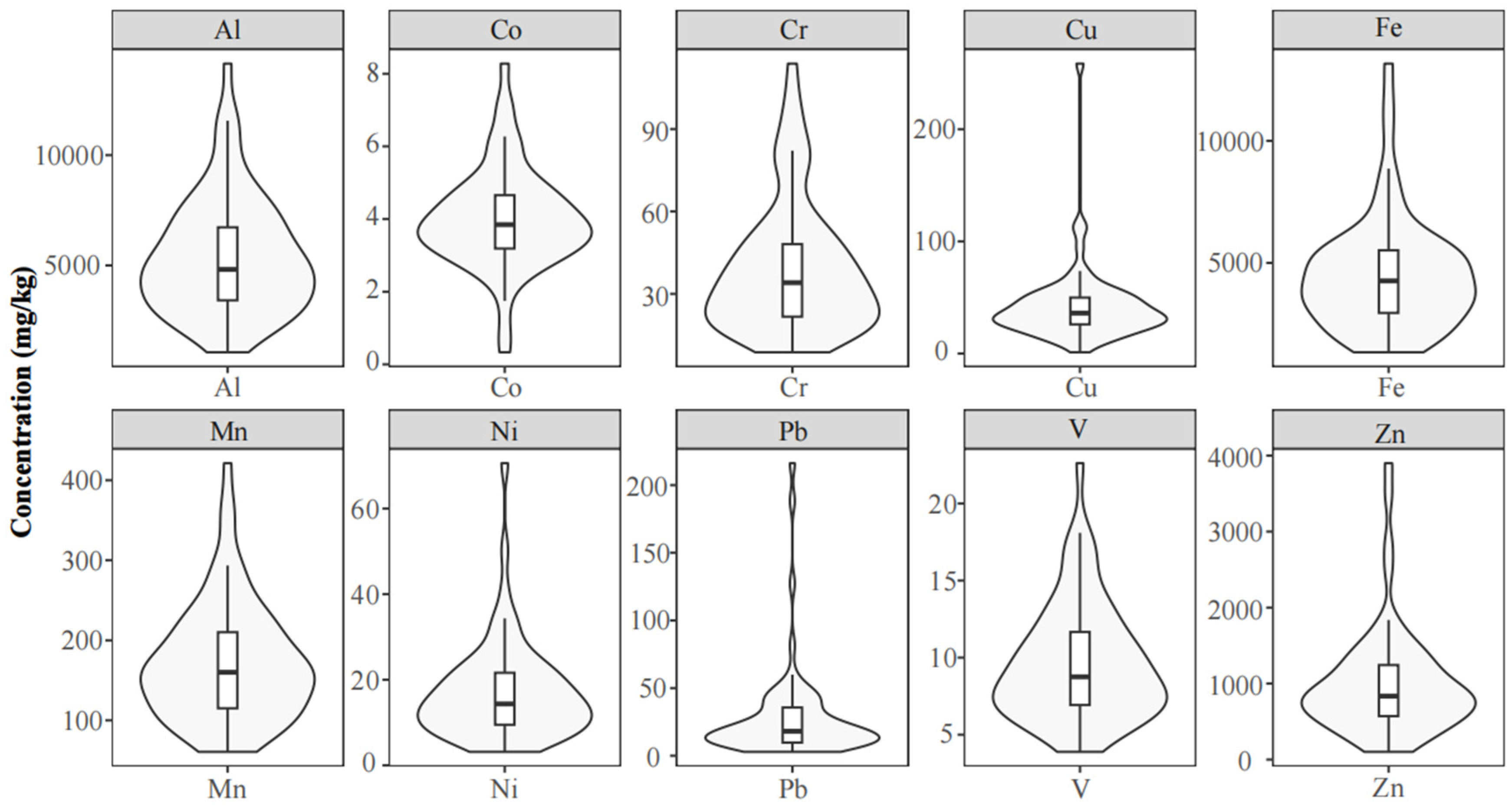

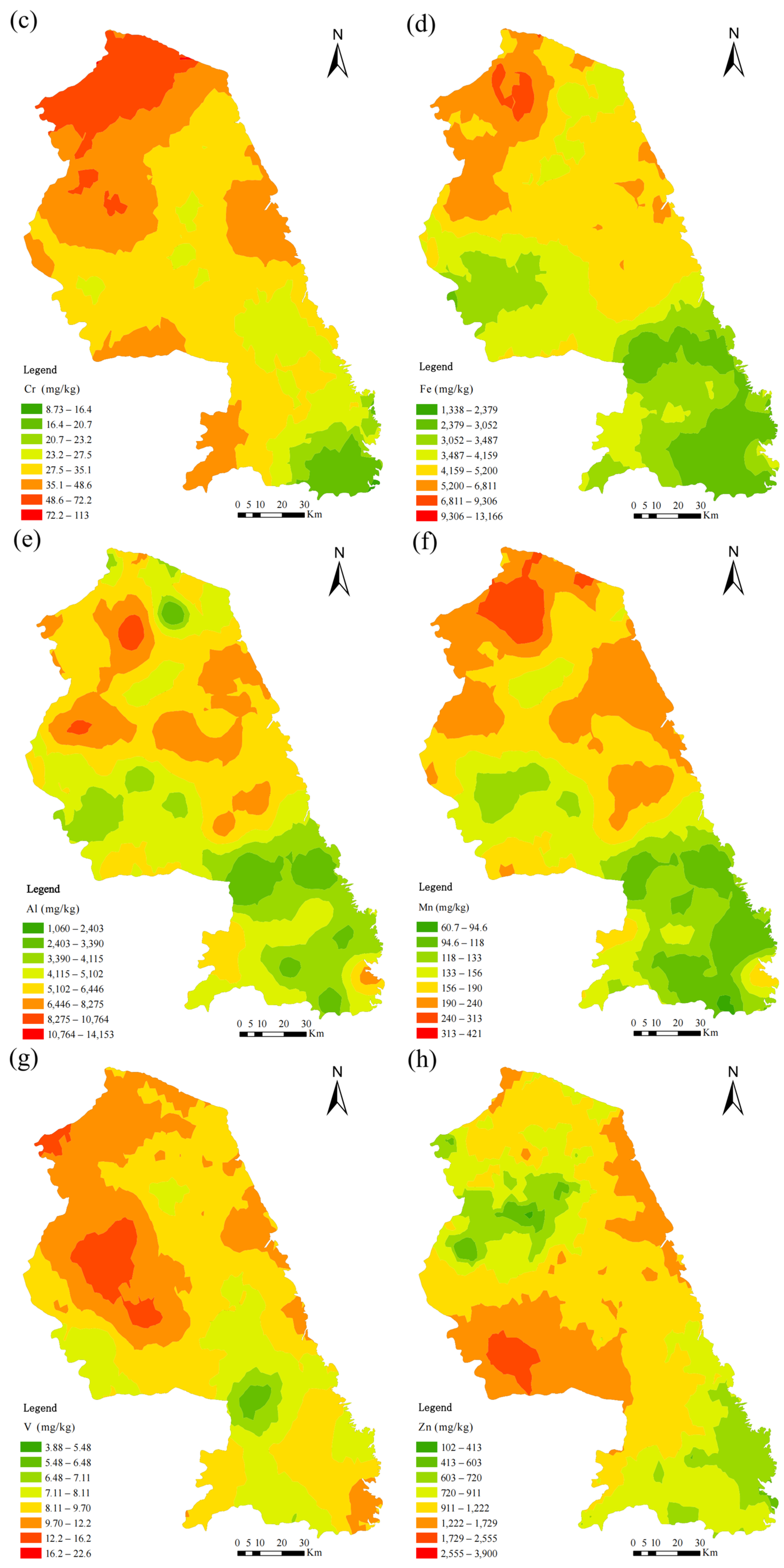
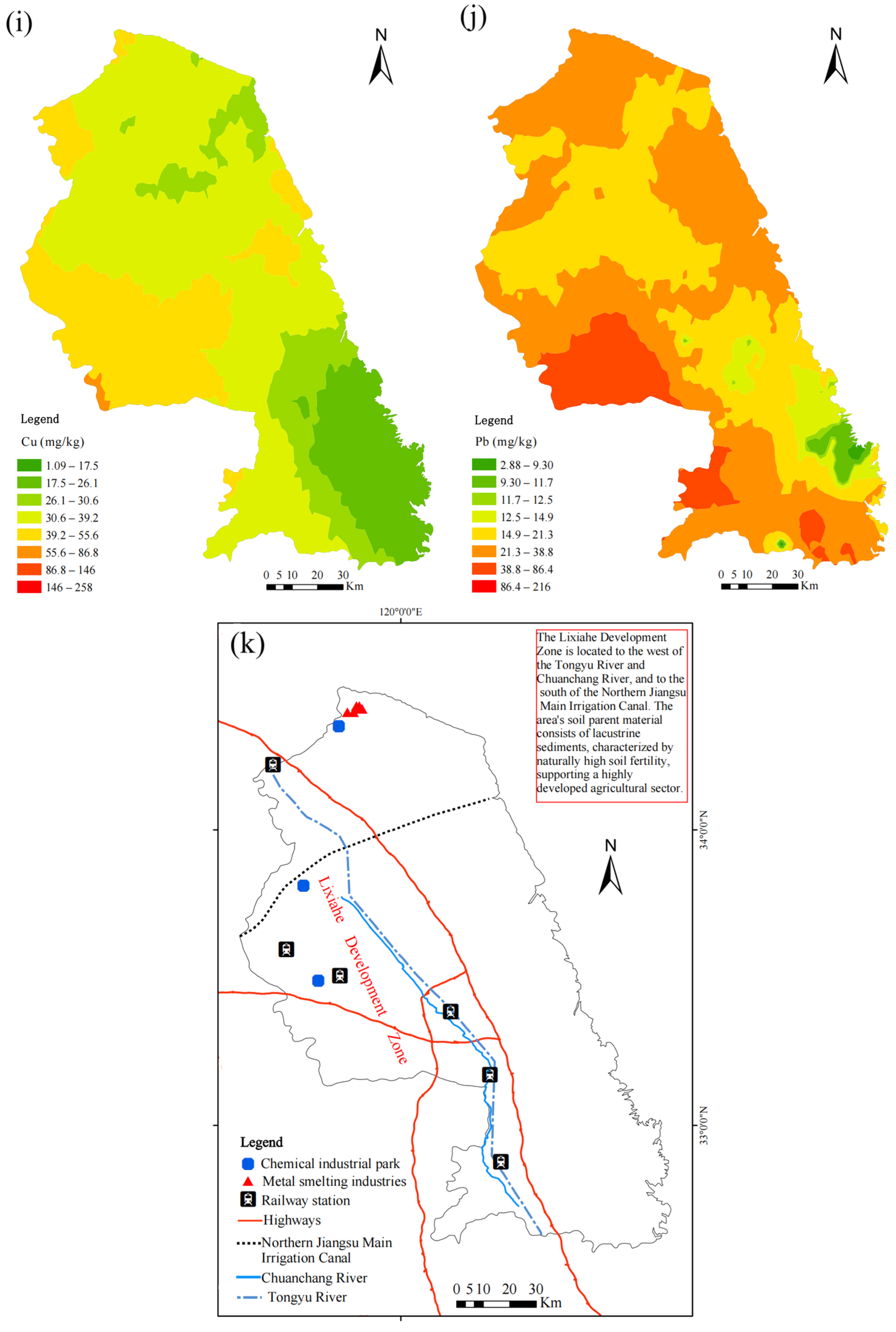

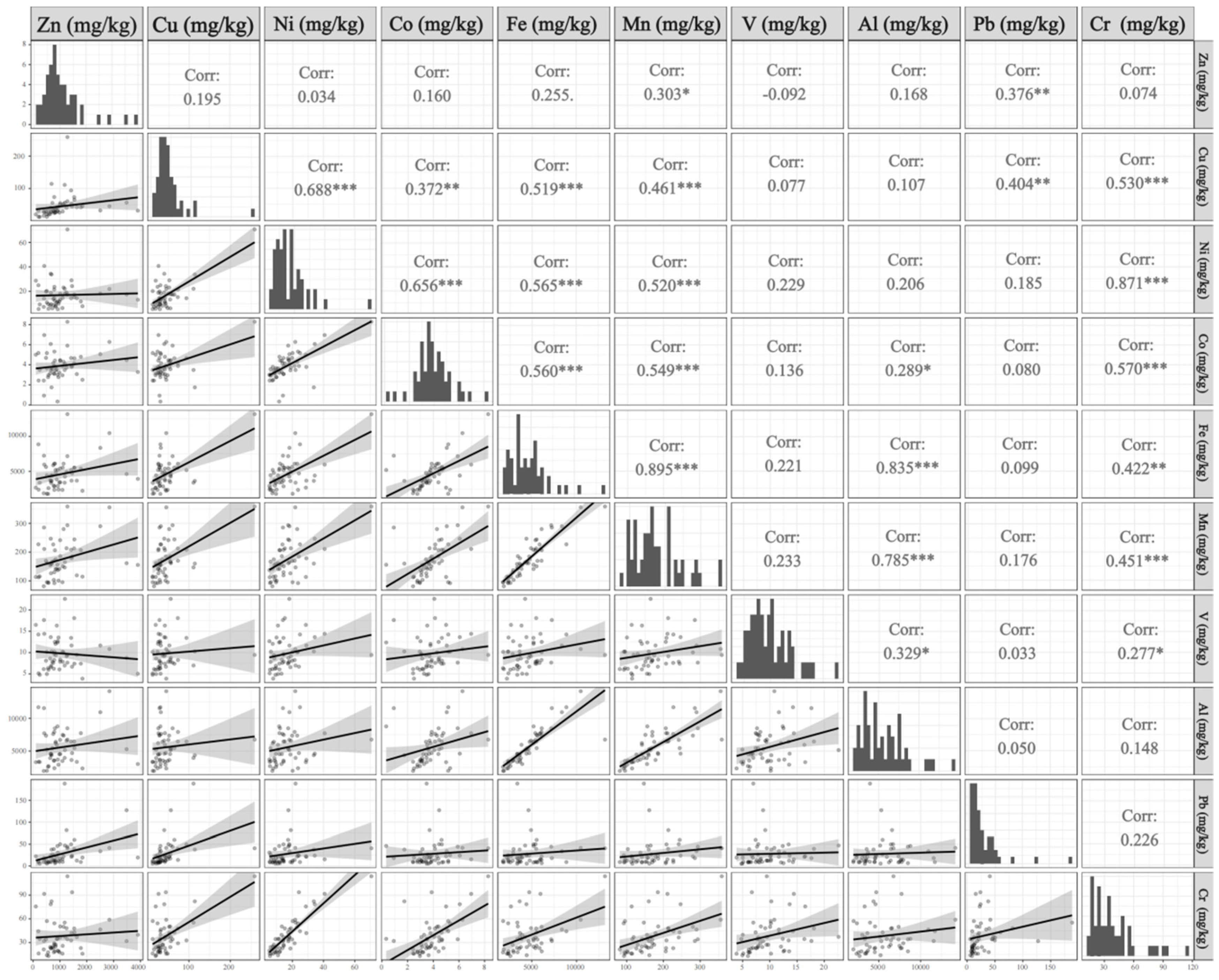
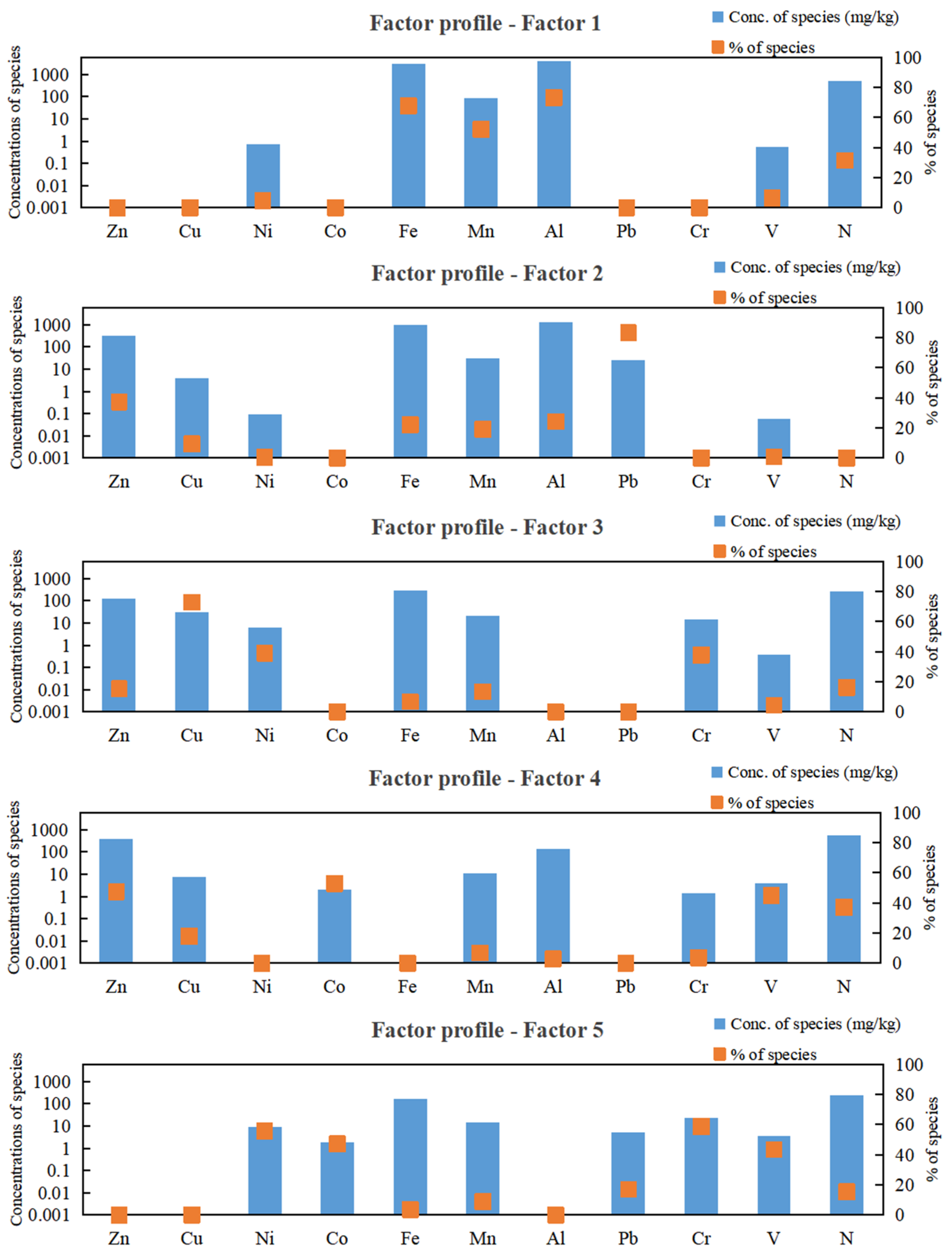
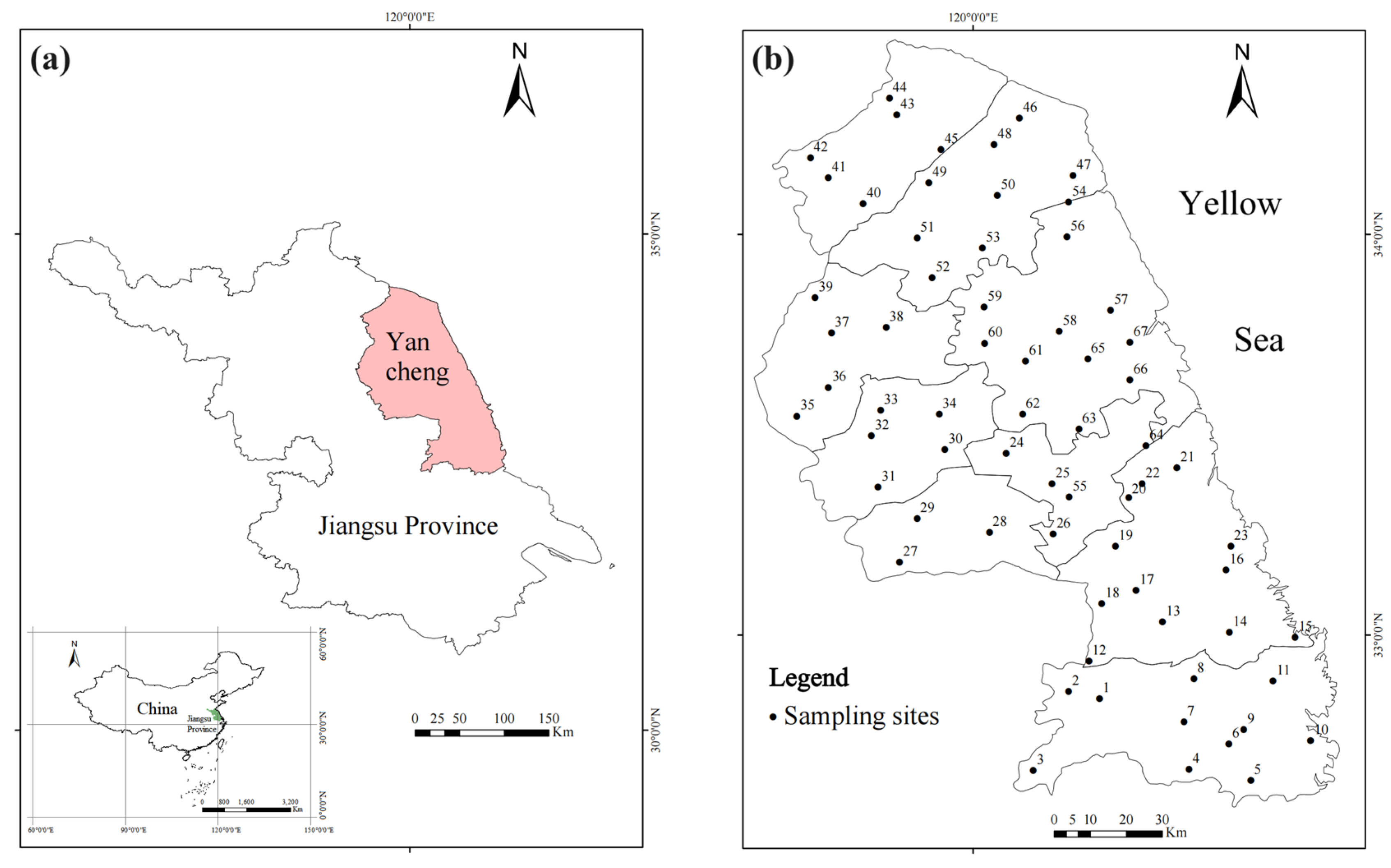
| Elements | Zn | Cu | Ni | Co | Fe | Mn | Al | Pb | Cr | V | N |
|---|---|---|---|---|---|---|---|---|---|---|---|
| Min | 102 | 1.09 | 3.16 | 0.33 | 1338 | 60.7 | 1060 | 2.88 | 8.73 | 3.88 | 0.85 |
| Max | 3900 | 258 | 70.6 | 8.28 | 13,166 | 421 | 14,153 | 216 | 114 | 22.6 | 3.81 |
| Median | 835 | 36.0 | 14.4 | 3.85 | 4263 | 160 | 4817 | 18.1 | 34.1 | 8.76 | 1.61 |
| Mean | 995 | 42.2 | 17.0 | 4.01 | 4517 | 171 | 5416 | 29.3 | 39.4 | 9.66 | 1.67 |
| SD | 701 | 34.1 | 11.3 | 1.38 | 2300 | 72.5 | 2642 | 36.9 | 23.7 | 3.74 | 0.53 |
| coefficients of variation (CVs, %) | 70 | 81 | 66 | 34 | 51 | 42 | 49 | 126 | 60 | 39 | 32 |
| Elements | Yancheng, China (Current Work) n = 67 | Mongolia [9] n = 39 | Norway [9] n = 228 | |||
|---|---|---|---|---|---|---|
| Median | Range | Median | Range | Median | Range | |
| Moss species | Haplocladium microphyllum | Hylocomium splendens Pleurozium Schreberi | Hylocomium splendens Pleurozium Schreberi | |||
| Zn | 835 | 102–3900 | 47.1 | 26.2–69.6 | 31.1 | 8.07–409 |
| Cu | 36.0 | 1.09–258 | - | - | 4.20 | 1.80–374 |
| Ni | 14.4 | 3.16–70.6 | 3.88 | 1.50–11.8 | 1.09 | 0.44–547 |
| Co | 3.85 | 0.33–8.28 | - | - | - | - |
| Fe | 4263 | 1338–13,166 | 4310 | 1960–11,000 | 307 | 78.4–8125 |
| Mn | 160 | 60.7–421 | - | - | - | - |
| Al | 4817 | 1060–14,153 | 8070 | 3510–19,300 | 461 | 98.4–3048 |
| Pb | 18.1 | 2.88–216 | 10.0 | 4.41–23.1 | 1.58 | 0.28–22.2 |
| Cr | 34.1 | 8.73–114 | 8.70 | 3.90–22.0 | 0.66 | 0.19–16.9 |
| V | 8.76 | 3.88–22.6 | - | - | 1.19 | 0.31–14.4 |
| Elements | Zn | Cu | Ni | V | Co | Fe | Mn | Al | Pb | Cr |
|---|---|---|---|---|---|---|---|---|---|---|
| CF (2022, n = 67) | 7.45 2 | 6.50 2 | 6.87 2 | 4.42 2 | 3.20 1 | 5.14 2 | 4.88 2 | 5.50 2 | 11.23 3 | 6.35 2 |
| CF (2017, n = 68) | 4.97 2 | 3.50 1 | 5.10 2 | 4.36 2 | — | 4.95 2 | 4.68 2 | — | 7.98 2 | 5.68 2 |
Disclaimer/Publisher’s Note: The statements, opinions and data contained in all publications are solely those of the individual author(s) and contributor(s) and not of MDPI and/or the editor(s). MDPI and/or the editor(s) disclaim responsibility for any injury to people or property resulting from any ideas, methods, instructions or products referred to in the content. |
© 2025 by the authors. Licensee MDPI, Basel, Switzerland. This article is an open access article distributed under the terms and conditions of the Creative Commons Attribution (CC BY) license (https://creativecommons.org/licenses/by/4.0/).
Share and Cite
Zhou, X.; Li, J.; Yan, P.; Lu, N.; Lu, L.; Ni, Q.; Zhang, J.; Fang, Y. Mosses as Biomonitors of Atmospheric Trace Metal and Nitrogen Deposition: Spatial Distribution and Temporal Trend in Yancheng, China. Plants 2025, 14, 1315. https://doi.org/10.3390/plants14091315
Zhou X, Li J, Yan P, Lu N, Lu L, Ni Q, Zhang J, Fang Y. Mosses as Biomonitors of Atmospheric Trace Metal and Nitrogen Deposition: Spatial Distribution and Temporal Trend in Yancheng, China. Plants. 2025; 14(9):1315. https://doi.org/10.3390/plants14091315
Chicago/Turabian StyleZhou, Xiaoli, Jing Li, Peng Yan, Nana Lu, Linyu Lu, Qian Ni, Junrong Zhang, and Yanming Fang. 2025. "Mosses as Biomonitors of Atmospheric Trace Metal and Nitrogen Deposition: Spatial Distribution and Temporal Trend in Yancheng, China" Plants 14, no. 9: 1315. https://doi.org/10.3390/plants14091315
APA StyleZhou, X., Li, J., Yan, P., Lu, N., Lu, L., Ni, Q., Zhang, J., & Fang, Y. (2025). Mosses as Biomonitors of Atmospheric Trace Metal and Nitrogen Deposition: Spatial Distribution and Temporal Trend in Yancheng, China. Plants, 14(9), 1315. https://doi.org/10.3390/plants14091315







